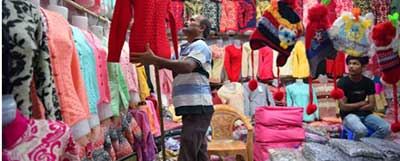Relevance: GS-3: Indian Economy and issues relating to Planning, Mobilization of Resources, Growth, Development and Employment.
Key Phrases: Supply side inflation, Demand side inflation, Wholesale food inflation, Medium-term inflation target, Structural change, Fiscal policy, Hawkish Monetary policy, Hyperinflation
Why in News?
- Retail inflation rose to a seven-month high of 6.01 per cent in January, breaching the upper tolerance level of the medium-term inflation target of 4+/-2 per cent set by the Reserve Bank of India (RBI), mainly on account of high food inflation, which jumped to a 14-month high of 5.43 per cent, along with an unfavourable base. Wholesale food inflation was at a 24-month high of 9.6 per cent, data released recently showed.
Why is the fresh surge in inflation a concern?
- Structural change in inflation: The high retail inflation is now
seen turning structural, with price rise in non-food segments such as
clothing, fuel and light, household goods, health, transport, and
communication being seen above 6 per cent.
- The structural aspect of inflation is reflected in the core inflation remaining sticky (5.96 per cent in January).
- Clothing & footwear inflation now stands at a 97-month high (8.84 percent) on the back of higher cotton prices. Household goods and services inflation at 7.1 per cent is at a 94-month high in January.
- Supply side inflation: Wholesale Price Index (WPI): based inflation rate, which is in double digits, is reflective of the price pressures on the inputs side and of manufacturers passing on the higher input costs to their output prices.
- High global inflation and rising crude oil prices will exert further pressure.
- Demand side inflation: Especially, when domestic demand rebounds after the abatement of the less severe third wave. The increased market opening with full swing will increase demand and inflation.

How does RBI view high inflation?
- RBI Governor Shaktikanta Das said there was no need to panic on the inflation front. “Today’s inflation print is expected to be around 6 per cent. So that should not surprise or create any alarm, because we have taken that into consideration,”
- RBI said “The rise in CPI inflation during October-December is mainly on account of the statistical effect of a low base”
- In its monetary policy review on February 10, RBI kept the key policy rates unchanged and maintained an accommodative stance. It also took note of the cost-push pressures on core inflation – the non-food, non-fuel component of inflation.
- The RBI has projected 5.3 per cent retail inflation for FY22, with Q4 inflation seen at 5.7 per cent before easing to 4.9 per cent in Q1 FY23.
What Is Inflation?
- Inflation is the decline of purchasing power of a given currency over time. A quantitative estimate of the rate at which the decline in purchasing power occurs can be reflected in the increase of an average price level of a basket of selected goods and services in an economy over some period of time.
Types of inflation:
Inflation is sometimes classified into three types: Demand-Pull inflation, Cost-Push inflation, and Built-In inflation.
- Demand-pull inflation occurs when an increase in the supply of money and credit stimulates overall demand for goods and services in an economy to increase more rapidly than the economy's production capacity.
- Cost-push inflation is a result of the increase in prices working through the production process inputs. These developments lead to higher costs for the finished product or service and work their way into rising consumer prices.
- Built-in inflation is related to adaptive expectations, the idea that people expect current inflation rates to continue in the future.
A country’s financial regulator, like the RBI in India, shoulders the important responsibility of keeping inflation in check. It is done by implementing measures through monetary policy, which refers to the actions of a central bank or other committees that determine the size and rate of growth of the money supply.
Methods to Control Inflation:
- Hawkish Monetary policy :- Higher interest rates reduce demand in
the economy, leading to lower economic growth and lower inflation.
- RBI can increase Statutory Liquidity ratio (SLR), Cash Reserve Ratio (CRR).
- During periods of high inflation, the RBI raises the repo rate to reduce the flow of money in the economy.
- Control of money supply –RBI may impose higher margin requirements, raising the cost of credit availability. As a result of less loan disbursement and less private investment, there is less demand and thus less inflation.
- Administrative Measures: To maintain price stability and control inflationary price rises in the economy. With acts like the Essential Commodity Act of 1955 or Drug Price Control Order (DPCO).
- Supply-side policies: Policies to increase the competitiveness and efficiency of the economy, putting downward pressure on long-term costs.
- Fiscal policy: Like, a higher rate of income tax could reduce spending, demand and inflationary pressures.
Conclusion:
- Inflation is not all bad, if it is in a regulated manner it is good for the growth of the country, that is why RBI also projects to keep inflation between 4-6%. However, if it's not under control then it will spiral, cause hyperinflation, and lead the economy to a vicious cycle. Therefore, necessary measures should be designed both by the central bank and the government to keep it in check.
Sources: Indian Express , Investo-Pedia
Mains Question:
Q. What are the various reasons for growing inflation in recent times? What measures can be deployed to control inflation. [250 words]








